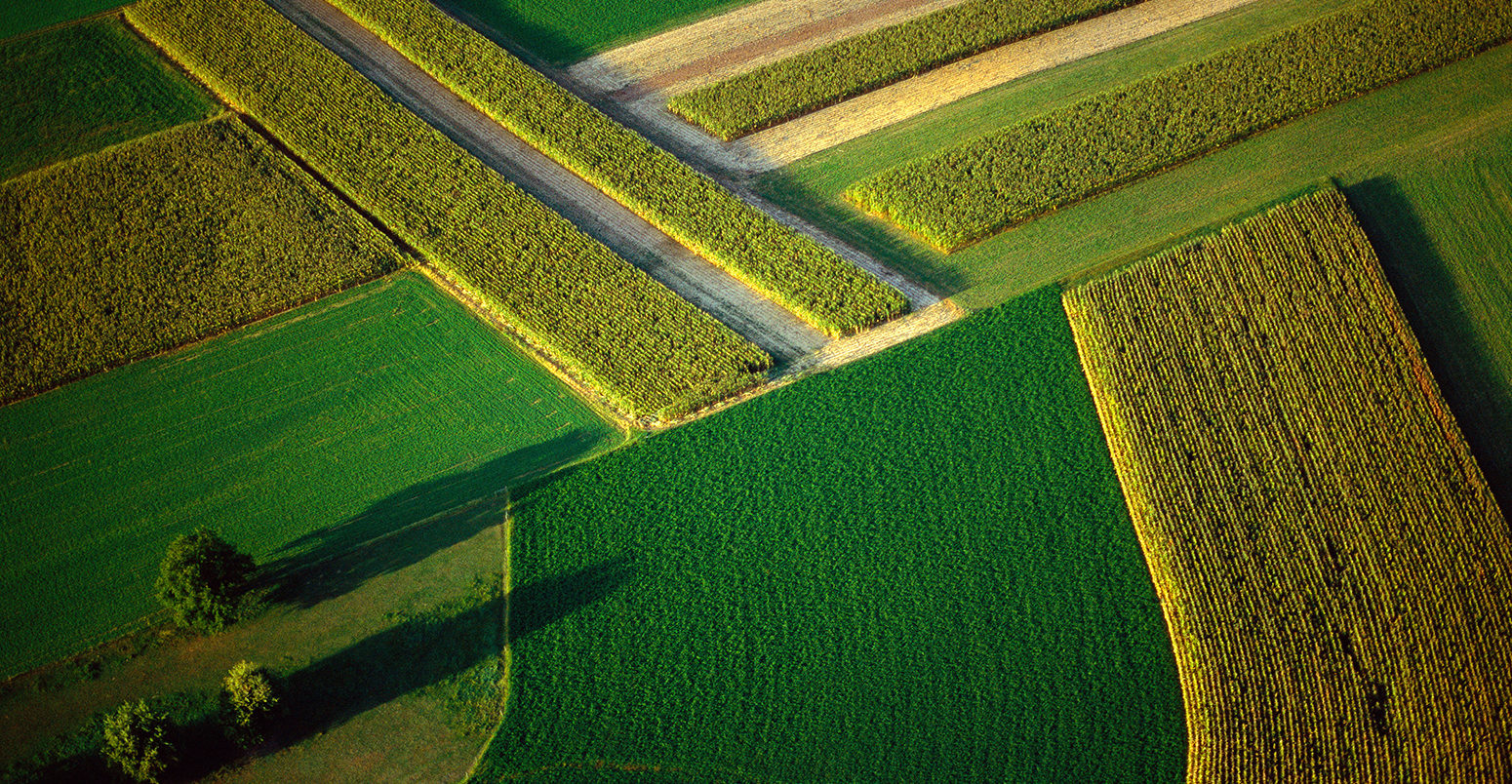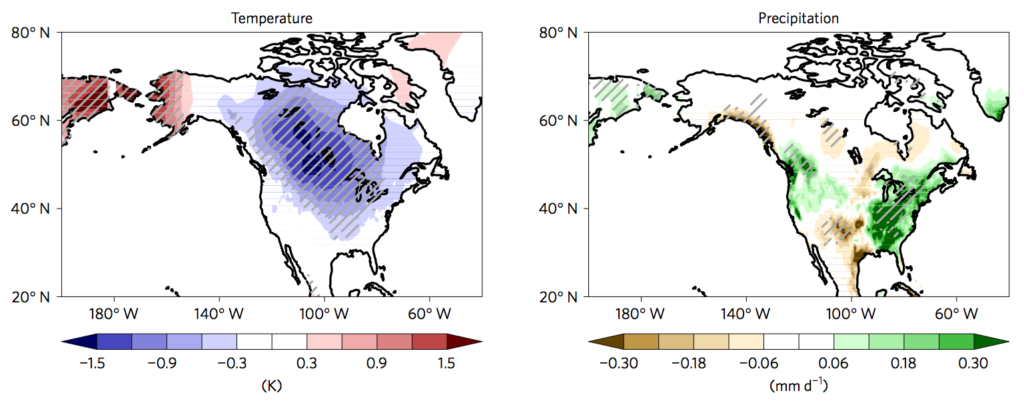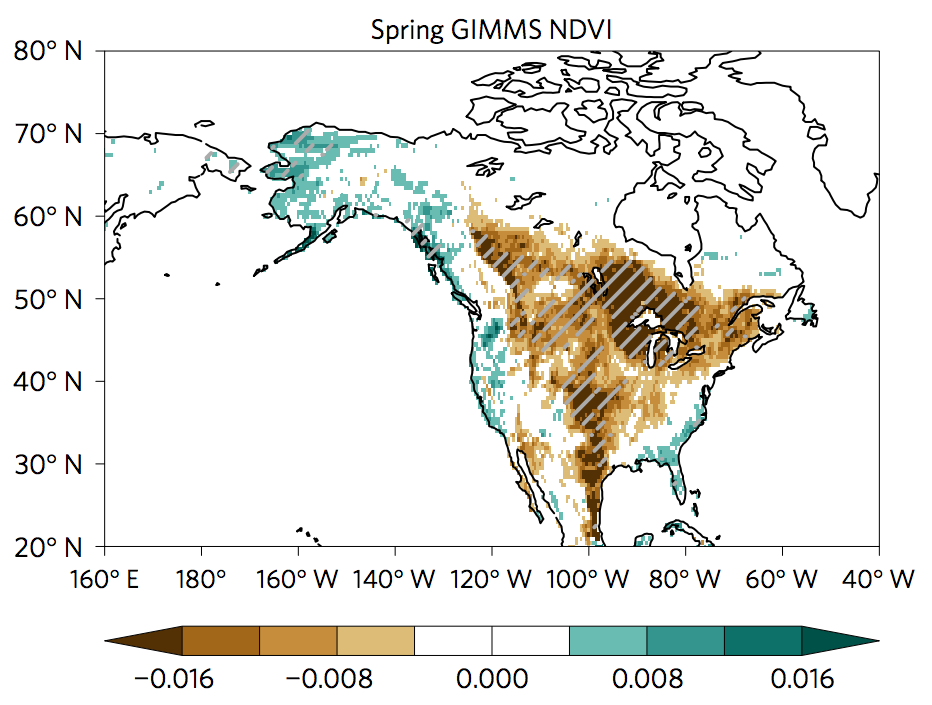
Warm spells in Arctic stunt crop yields across US, study suggests
Robert McSweeney
07.10.17Robert McSweeney
10.07.2017 | 7:50pmUnusually warm periods in the Arctic stunt vegetation growth and crop yields across North America, a new study suggests.
The study is a new angle on the relatively recent area of research connecting rapid warming in the Arctic with the weather of mid-latitude regions.
Reduced plant and crop growth is down to two factors, the researchers say: severe cold in northern North America and dry conditions in south-central US. These are both linked to very warm spring temperatures in the Arctic, the study says.
But while the study adds to the weight of evidence that there is a connection between a warm Arctic and mid-latitude weather, it doesn’t tackle the “critical question” of whether one causes the other, another scientist tells Carbon Brief.
Arctic amplification
Temperatures in the Arctic are increasing around three times as fast as the global average – a phenomenon known as Arctic amplification. One of the main reasons is the loss of sea ice in the region. As the extent of the sea ice declines, energy from the sun that would have been reflected away is instead absorbed by the ocean.
In addition to the direct impacts of rapid Arctic warming – most notably the loss of sea ice – scientists also think that it could be having an indirect effect on weather patterns in the mid-latitude regions of the northern hemisphere.
This relatively recent – and sometimes controversial – area of research has linked a warming Arctic with very cold winters in the UK, North America and Central Asia, as well as longer-lasting summer heatwaves in Russia.
The new study, published in Nature Geoscience, takes the theory a step further – not only linking a warm Arctic to unusual weather patterns in North America, but also to the impacts on plant growth and crop yields.
Cold and dry conditions
The study builds on the researchers’ earlier work, published in 2015, which pinpoints the specific areas in the Arctic Circle where unusually high temperatures appear to be driving severe weather in mid-latitude countries.
That research found that higher-than-average temperatures over the East Siberian-Chukchi Sea region of the Arctic were often followed by severe winters in North America.
This time, the researchers focus on spring, rather than winter. Analysing surface temperature data for 1979-2015, they link a warm Arctic during March to colder-than-average temperatures over northern regions of North America and dry conditions in central southern areas between March and May.
You can see this in the maps below, which show the average response of spring temperatures (left) and rainfall (right) in North America following the warmest 16% of March Arctic temperatures. The blue shading indicates cold conditions, and the brown shading shows the dry areas.

Average spring (March to May) temperature (left) and rainfall (right) response for the warmest 16% of Arctic March temperatures between 1979-2015. Shading in the left-hand map indicates cold (blue) and warm (red) temperatures (in degrees), and in the right-hand map shows dry (brown) and wet (green) conditions (in mm per day). Hatching indicates statistically significant results. Source: Kim et al. (2017)
You can read about how a warm Arctic could be causing cold and dry weather in North America in our coverage of the earlier study. In short, a rapidly warming Arctic weakens the jet stream – a river of high-speed winds flowing west to east high up in the atmosphere – and this weaker, wavier jet stream then draws cold air from the Arctic over North America.
As well as bringing chilly conditions to the residents of North America, the cold weather restricts plant growth, the research finds.
Spring is a critical time for many plants as they’re just emerging after winter. A sudden cold snap can damage new leaves, affecting growth even once temperatures have recovered. Similarly, a spell of dry weather can stunt the growth of plants in the drier, southern regions of the continent.
Data from satellite images shows that vegetation growth is lower following a warm Arctic during March. This impact continues throughout spring and even into early summer.
You can see this from the brown-shaded area in the map below. The area of reduced plant growth extends “from the boreal coniferous forests in Canada to the subtropical steppe in Mexico”, the paper says.

Average spring (March to May) normalized difference vegetation index in response to the warmest 16% of Arctic March temperatures between 1982-2013. Shading indicates low (brown) and high (green) vegetation growth. Hatching indicates statistically significant results. Source: Kim et al. (2017)
Slower plant growth means the land surface takes up less CO2 from the atmosphere. The researchers estimate that a warm Arctic causes a decrease in annual carbon uptake in North America of 100m tonnes. This “corresponds to about 14% of the average North American sink”, writes Dr Ana Bastos, from the Laboratoire des Sciences du Climat et l’Environnement, in an accompanying News & Views article.
On the whole, the Earth’s land surface has “greened” in response to rising CO2 emissions and warmer temperatures, but these new results suggest there could also be a negative impact of climate change on vegetation growth in North America.
However, “whether the relationship found implies a decreasing carbon sink capacity of North American ecosystems in the coming decades is unclear”, Bastos notes.
Crop yields
The impacts of a warm Arctic also extend to the farmers of North America, the research suggests.
Analysing data for US annual harvests of corn, soybeans and wheat, the study finds that yields were approximately 2%, 4% and 4% lower, respectively, in “warm” Arctic years compared to “cold” years.
The differences are much larger for individual states, which you can see in the maps below, These show the difference in tonnes of crop per hectare in warm Arctic years compared to cold years.
The most severe declines in crop yields are shown in dark brown. For example, farmers in Texas harvested more than a tonne less corn per hectare during warm Arctic years. This equates to about 20% of average yields in this region, the researchers say.
There is a small positive impact on yields of wheat in northwestern US (shaded green), the study finds, which is likely a result of higher rainfall in this region during warm Arctic years. On the opposite side of the US, the states of New York, Pennsylvania and West Virginia show a significant dip in wheat yields in warm Arctic years.

Differences in annual US crop yields in “warm” Arctic years when compared to “cold” years, for corn (left), soybeans (middle) and wheat (right). Shading indicates lower (brown) or higher (green) yields in warm Arctic years. The numbers within each state show the statistically significant results in tonnes of crop per hectare per year. Pale shading in each state shows non-significant results, and white shading indicates states with insufficient data. Source: Kim et al. (2017)
‘A deeper look’
While the new study adds to the weight of evidence that a warm Arctic and mid-latitude weather are linked, it doesn’t look at whether one causes the other, says Dr James Screen, associate professor of climate science at the University of Exeter, who wasn’t involved in the study. He tells Carbon Brief:
“It is still far from clear whether cold anomalies [in the mid-latitudes] are caused by Arctic warming (or sea ice loss) rather than being simply correlated with Arctic warming, but driven by something else. This paper fails to make any headway on that critical question.”
Indeed, as Prof Jennifer Francis from Rutgers University – who also wasn’t involved in this study – discusses in a paper from last week, the exact nature of links between the Arctic and mid-latitudes are not yet clear:
“The specific roles of rapid Arctic warming and sea ice loss in this story are a topic of intense research and controversy. Instead of converging on answers, however, the science seems as unsettled as ever.”
Whatever the extent of the link, it is unlikely to be a simple case of cause-and-effect, says Bastos in the News & Views article. She writes:
“It is likely to vary between seasons, regions and the warming versus cooling states, and nonlinear effects or additional factors must be taken into account.”
Getting to the bottom of the links and their causes will, therefore, likely require more sophisticated model experiments, she concludes:
“A deeper look at the differences between the different land surface and Earth system models may help better constrain the response of mid-latitude ecosystems to climate variability.”
Kim, J-S et al. (2017) Reduced North American terrestrial primary productivity linked to anomalous Arctic warming, Nature Geoscience: doi:10.1038/ngeo2986 Bastos, A. (2017) Warmer Arctic weaken vegetation, Nature Geoscience, doi:10.1038/ngeo2989

